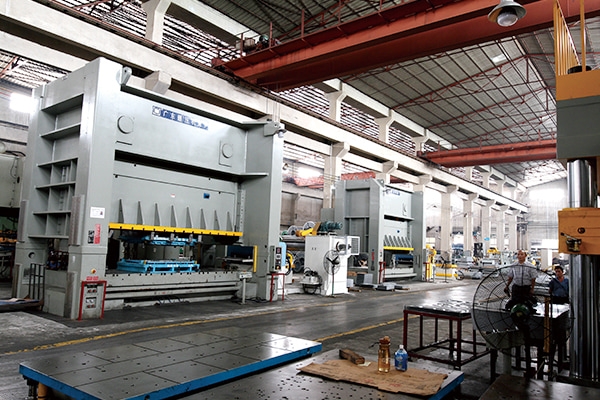
Definition of Mechanical Press: A Quick Guide
A mechanical press is a machine used to force materials into shape by compression. It can be used to make items from metal, wood, and plastics. The application of mechanical presses is found in many modern industries, including food processing, automobile manufacturing, the paper industry, and even in the jewelry-making industry. The following article will provide you with the information you need to get started using mechanical presses.
Mechanical Press Definition: What Exactly is It?
A mechanical press is a machine that can be used to apply pressure to a material. It can also be used to exert force on the surface of an object. These machines are used in various industries and are commonly employed in manufacturing processes.
Mechanical presses are very similar to hydraulic presses, in that they both employ hydraulic systems to push materials through their pistons and shear blades. However, there are some key differences between the two types of machines. For one thing, mechanical presses do not use electricity or hydraulics as part of their operation; they rely solely on the force applied by their pistons and shear blades to move objects through them.
Mechanical presses also differ from hydraulic presses in terms of the type of materials they can process. A hydraulic press may be able to handle any type of material that it needs to work with; however, a mechanical press will only be able to handle certain materials depending on its design and specifications.

Things You Didn’t Know About The Definition of Mechanical Press
The definition of the mechanical press is a machine that uses the force of gravity to move material through a machine. The basic principle is that the weight of the material being transported by the machine pulls down on anvils which in turn drive hammers that strike against dies or punches to apply pressure to form metal parts.
The first mechanical presses were developed in the 16th century and were used by printers and booksellers. These presses could handle paper, cloth, leather, and other materials. Mechanical presses are used to make different types of products, including books, paper, cloth, and even plastic. They can also be used to produce metals and other raw materials.
There are many types of mechanical presses available on the market today. Some are designed for small businesses while others are designed for large companies that need more than one machine. There are other types of mechanical presses as well, including hydraulic and electric presses. Electric presses are used for small-volume applications while hydraulic presses are used for larger volumes of production work.
Mechanical Presses Explained – Now You Know The Basics
A mechanical press is a device that uses force to squeeze objects. It is an industrial machine used for pressing, stamping, forming, and coating materials.
Mechanical presses can be used either as single or multi-stage presses. They can also be combined with other types of equipment such as conveyors, vibrators, rotary tables, and extruders to form a complete processing line.
The mechanical process of pressing allows the user to apply varying amounts of force on each operation by using a variety of different motors and pumps. This ensures uniformity in pressing operations, which improves the quality of finished products while reducing production costs.
The power requirements for most types of mechanical presses are relatively low compared to other types of machinery because they only require electrical energy for moving parts such as pistons, gears, and rollers rather than large amounts of electricity for heating up hot dies or turning screws etcetera which increases their overall efficiency and reduces running costs substantially over time.
How Mechanical Presses Work – According To Experts!
The mechanical press is a machine that has a series of rollers or plates that pushes the material through the machine. The rollers are usually made of aluminum, steel, or cast iron. In addition to the rollers, there are also many other parts that help to make the machine work properly.
The most important part is the spindle, which is driven by a motor. The spindle rotates at high speeds and presses down on the material with great force. This pressure causes the material to be squeezed through the die head and into your desired shape.
The die head consists of two parts: The top die and the bottom die. Both of these parts are made from precision-machined aluminum components that fit together perfectly so that when you put in your material it will be pressed into shape as it goes through each stage of processing by your machine.
How a Mechanical Press Works – And What It’s Good For?
The Guangduan mechanical press is a manually operated press with vertical transmission. The headstock of the machine is located above the horizontal axis, which means that the pressing dies are mounted on top of it.
Mechanical presses are suitable for pressing different types of materials, such as metals, plastic, and wood. They are used in many industries such as the automotive industry and the construction sector.
The Guangduan mechanical press has been designed to be used in a variety of applications. For example, its many features make it ideal for producing aluminum sheets from aluminum ingots as well as for assembling motor vehicle wheels.
Concluding Remarks
A mechanical press is a device that makes use of the force of gravity and a lever to affect a change in the volume or pressure of a material. The mechanical press is usually used to apply pressure, but it can also be used to compress, expand or squeeze a material. It is one of the most popular and widely used devices in modern manufacturing, especially in the packaging industry.
CONTACT US


Guangdong Metal Forming Machine Works Co., Ltd.
We are always providing our customers with reliable products and considerate services.
If you would like to keep touch with us directly, please go to contact us



